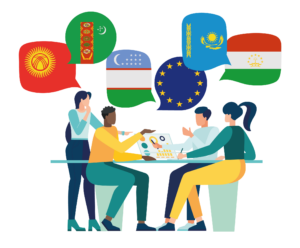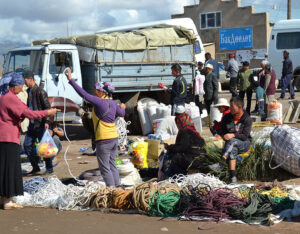European National Policies Series – Sweden and Central Asia

Download “European National Policies Series - Sweden and Central Asia” EUCAM-National-Policies-Brief-15.pdf – Downloaded 473 times – 580.39 KB
Sweden is a small, neutral country. Its foreign policy is based on working with, and through, international institutions, especially the European Union (EU). Sweden has been a leader in shaping a strong European External Action Service (EEAS) and in calling for a long-term European Global Strategy. In Central Asia, Sweden has been a firm supporter of the EU’s policies and activities, particularly regarding human rights and democratisation.
The Swedish foreign ministry’s interest in Central Asia has recently been re-activated in light of the security concerns stemming from NATO’s 2014 withdrawal from Afghanistan. The Swedish International Development Cooperation Agency (SIDA) has completely phased out its bilateral development cooperation in Central Asia. However, the Swedish foreign ministry is working to gradually establish a wider and more strategic multi-track political agenda in the region, balancing political and security interests with its global effort to promote democratic values and human rights. This ambition is being pursued mainly through the EU and other multilateral bodies, including the Organisation for Security and Cooperation in Europe (OSCE) and the UN family of organisations. As a self-proclaimed ‘humanitarian superpower’, Sweden is also active in delivering humanitarian aid worldwide, including to Central Asia.(1)
Economic relations between Sweden and Central Asia remain limited, but they are developing in a generally positive direction, despite recent political controversies in the telecommunications industry. Kazakhstan is Sweden’s main trading partner in the region. To a large extent, this accounts for the recent strengthening of bilateral diplomatic and business relations between the two countries.
Political relations and values
Sweden’s main aim in its political relations with Central Asia is to promote peace, stability and economic development by strengthening Central Asian countries’ independence and sovereignty in their progress towards democracy, market economies and respect for human rights. In 2011, the Swedish Ministry for Foreign Affairs reviewed the human rights situation in Central Asia as part of its series of human rights country reports. The reports examine civil and political rights, economic, social and cultural rights, and the rights of minorities in each of the region’s five countries. They conclude that the human rights situation remains serious, with no improvements in any of the five states. Turkmenistan and Uzbekistan have the most oppressive regimes in the region. Kazakhstan and Kyrgyzstan are at the other end of the scale, although recent developments in both countries suggest that the situation is worsening. In Kazakhstan, the regime is becoming increasingly oppressive in response to growing opposition. Kyrgyzstan is dealing with a combination of poverty, corruption and a weak rule of law following the 2010 revolution.(2) Sweden has traditionally granted political asylum to vulnerable Central Asian citizens. Since 2009, the Swedish Migration Board has granted asylum to 141 Uzbeks, 48 Kazakhs, 44 Kyrgyz, 3 Turkmens and 1 Tajik.(3)
Sweden has been a vocal supporter of the European Union’s policies as laid out in the 2007 policy document ‘The EU-Central Asia: Strategy for a New Partnership’, which promotes a values- based approach to cooperation with the region that foregrounds human rights and democracy, as opposed to an interests-based approach. During the Swedish EU presidency in 2009, Sweden called for the renewal of attempts to forge closer relations with Central Asia and pursued the implementation of the EU-Central Asia Strategy. Two EU-Central Asian ministerial meetings were organised: one in Brussels, which included all the five Central Asian states, and one in Dushanbe, with Kazakhstan, Turkmenistan and Uzbekistan. Both meetings were chaired by Swedish foreign minister Carl Bildt. This approach was reinforced in 2010 when, during the revolution and subsequent inter-ethnic violence in Kyrgyzstan, the Swedish foreign minister said that the EU had a special role to play in Central Asia in standing up for values such as human rights, the rule of law and democracy. Shortly thereafter, Sweden seconded an adviser to the EU Special Representative for Central Asia based in Bishkek and a political officer to the EU Delegation, appointed in 2011. Sweden has since worked closely with both of these institutions. Sweden also provided financial support to the Independent International Commission of Inquiry into the Events in Southern Kyrgyzstan in June 2010.
Since the fall of the Soviet Union, Sweden has had fairly frequent bilateral contacts and diplomatic relations with most of the Central Asian countries, with the exception of Turkmenistan. In February 2013, the Swedish chargé d’affaires appointed to Kazakhstan in 2010 was upgraded to ambassador. The four remaining Central Asian states are covered by one Swedish ambassador, who is based in Stockholm but makes frequent visits to the region.
There have been a few high-level visits between Sweden and Central Asia. Following a visit to Stockholm in March 2013, Kazakh foreign minister Erlan Idrisov announced that in 2013 Kazakhstan will become the first Central Asian state to open an embassy in Stockholm with the objective of strengthening relations between the two countries. Swedish foreign minister Carl Bildt visited Tajikistan in 2009 to take part in the EU Troika ministerial meeting, and Kazakhstan in 2010 to where he returned in April 2013 for a three-day visit to attend the Heart of Asia International Conference aimed at achieving stability in Afghanistan.
Trade and energy
Sweden is increasing its relatively limited economic and trade relations with Central Asia. The value of Sweden’s exports to the region grew by 20 per cent between January 2012 and January 2013, and the value of imports increased by 243 per cent. But trade flows between Sweden and Central Asia amount to only 0.1 per cent of Sweden’s total trade.
In order of importance, Swedish exports to Central Asia consist of machines, computers, electronics and optics, chemicals and chemical produce, paper and paper merchandise, and metals. Imports from Central Asia to Sweden are more diversified. They include metals, agricultural and game products, waste disposal and recycling services, groceries and food products, and computer, electronics and optics.(4)
Like other EU member states, Sweden’s industry sector is particularly interested in the Kazakh market, and especially in the telecoms and engineering sectors. Sweden currently has four bilateral trade agreements with Kazakhstan. Recently, the Swedish foreign ministry, in cooperation with Business Sweden-the Swedish Trade & Invest Council, jointly financed the appointment of a representative in Almaty to build up competences and make contacts in the Kazakh market. In 2012, Business Sweden organised a visit to Kazakhstan by a large Swedish delegation made up of 13 companies from the railway sector. Business Sweden is also promoting an online anti-corruption portal to the Central Asian countries, which offers targeted support to small and medium enterprises to help create a better business environment.(5)
However, there was a recent controversy between Sweden and Central Asia involving the telecommunications industry. TeliaSonera, a Swedish-Finish telecommunications giant that is 37.7 per cent owned by the Swedish government, is present in Central Asia and owns large shares in telecoms companies in Uzbekistan, Kazakhstan and Tajikistan. Swedish public broadcaster Sveriges Television (SVT) carried out an investigation in 2012 that concluded that TeliaSonera had been complicit of human rights abuses in the former Soviet Union. Also, in exchange for lucrative business deals, the company had allegedly given authoritarian regimes and their security services unlimited access to clients’ phone calls, data and text messages, which have been used as a basis to arrest and assault citizens.(6) TeliaSonera initiated an independent investigation, which found that the company failed to carry out proper background checks and due diligence. However, it determined that allegations of bribery could not be confirmed.(7) Nonetheless, in February 2013 TeliaSonera CEO Lars Nyberg resigned. In a press release issued on 1 February 2013, TeliaSonera announced that it intends to continue doing business in the region, but that human rights and anti-corruption efforts will be strengthened.
In energy cooperation, Sweden focuses mainly on environmentally-sustainable initiatives. It is open to exploring ideas for diversifying energy resources and it is increasingly involved in trade related to sustainable energy solutions, waste disposal and recycling services. Because Sweden supports the EU’s energy policy, it is also contributing to discussions with Turkmenistan on the Trans-Caspian gas pipeline, although Sweden prefers to move away from natural gas. For Sweden, energy in Central Asia is primarily an integral part of foreign and security policy processes, especially in light of the region’s developing relationships with China and Russia.
Security
Central Asia is currently peripheral to Sweden’s foreign policy, but it is likely to become more important as the 2014 drawdown of NATO troops from Afghanistan approaches. Sweden’s 2013 Statement of Government Policy on Foreign Affairs confirms Sweden’s long-term commitment to peaceful economic and social development in Afghanistan. Sweden is committed to working with neighbouring states to support the fight against corruption and the promotion of human rights and democratic principles, with a particular emphasis on women’s rights. Sweden, along with the EU, has been encouraged by Turkmenistan’s new willingness to play a part in strengthening regional security cooperation. Sweden is thus trying to take advantage of the window of opportunity in the run-up to the international troop withdrawal from Afghanistan in 2014 to improve dialogue with Turkmenistan.
Sweden has been contributing to the International Stability Force in Afghanistan (ISAF) since 2002, and from 2006 onwards the country has been leading a military force in the north of the country. In 2012, the Swedish force was transformed into a combined civilian and military unit and renamed the Transition and Support Team, under the leadership of a senior civilian representative. Sweden has around 500 troops stationed in Afghanistan. In 2013, this number will be reduced to 370 troops, in connection with a new Nordic-Baltic cooperation programme.(8) Sweden is also one of 14 states that support the countries of the Heart of Asia (including all the five Central Asian states) in their commitment to the Istanbul Process on Regional Security and Cooperation for a Secure and Stable Afghanistan.
In 2009 during the annual EU-Central Asia Ministerial Conference, the Swedish foreign minister underlined the key role of Central Asia in Afghanistan’s stability, as well as that of the region at large. Given the growing strategic importance of cooperation between the two regions, Sweden is emphasising the need to ensure that the High Level EU-Central Asian Security Dialogue, set to be held for the first time in June 2013, is given the necessary resources to achieve its aims.(9) The region is driven by disunity, and uncertainties persist in some countries about political succession. Thus, for Sweden it is important that the EU is in a position effectively to fulfil its ambitions in promoting security, cross-border trade and people- to-people contacts. The EU must also be able to implement projects to promote long-term security, stability and prosperous societies post-2014.
Involvement in multilateral organisations is an important part of Sweden’s contribution to security in Central Asia. Sweden is a strong advocate of the OSCE’s common principles, and is a leader in strengthening the EU’s voice and political influence within the organisation. Sweden also supports OSCE activities and greater involvement in Central Asia, and advocates for increasing the body’s capacity in the areas of conflict management, conflict resolution and the prevention of transnational threats. The country provides support to the OSCE Border Management Staff College in Dushanbe, which offers specialist training to senior border officials from OSCE states plus Afghanistan. It also backs the OSCE Community Security Initiative in Kyrgyzstan, a programme of unarmed civilian police advisers who have since November 2010 helped to support police working in a multi-ethnic environment to protect human rights and improve community-police relations.
As one of the largest donors to UN agencies, Sweden also contributes to the UN Office on Drugs and Crime (UNODC) in Central Asia. UNODC works to combat drug and human trafficking, which are both significant concerns that will be of particular importance in the post-2014 environment. Sweden closely monitors processes of regional integration and disintegration in Central Asia, which present a continued risk of renewed ethnic conflict, as well as the potential for extremism and terrorism in the region.
Development assistance
After 14 years of development cooperation with Central Asia, the Swedish International Development Cooperation Agency ended its activities in the region in 2010, with the exception of some minor humanitarian assistance. This followed a decision by the Swedish government on 27 August 2007 to render development cooperation more effective by focusing on certain countries, reducing the total number of aid recipients from 70 to 33 states.
Between 1998 and 2008, Sweden’s annual support to Central Asia gradually increased from SEK 11 million to SEK 153 million (approximately €1.3 million to €17 million). By the end of 2010, the total was just under SEK 900 million (approximately €103 million).(10) In 2004, SIDA opened a Section Office for Development Cooperation in Dushanbe to coordinate its activities in the region. SIDA’s working methods in Central Asia were characterised by the principle of ‘ownership’, which, in practice, translated into supporting on-going reforms on the basis of national poverty reduction and development strategies. This meant that SIDA worked primarily with government agencies, even though a self- evaluation of Central Asian development assistance in 2002 found that the projects that focused on grassroots initiatives had been the most successful. SIDA also worked in close partnership with other bilateral and multilateral donor organisations and international NGOs.
Originally, SIDA’s focus in Central Asia was primarily on democratic processes and human rights, followed by the social sector, and the majority of funds were allocated to Kazakhstan, Uzbekistan and Tajikistan. Sweden’s Regional Strategy for Central Asia 2003-2005 was drawn up with the goal of reducing poverty and preventing conflict through promoting sustainable growth, higher living standards, democratic governance and human rights. Linkages between poverty, unemployment, democracy and conflict were clearly outlined. The strategy emphasised donor coordination, capacity building and alignment with the countries’ own strategies.
In 2005, Sweden developed a new 2006-2009 regional strategy for Central Asia. This strategy focused on poverty alleviation, moving away from involvement in national reform efforts. It envisaged fewer and bigger interventions in smaller areas and demanded continued attention to conflict reduction and close donor coordination. In Kyrgyzstan and Tajikistan, three main sectors of cooperation were identified: democratic governance, economic development and health, with gender equality being a priority across the three.
Sweden’s development aims remained the same under the 2008-2010 phase-out strategy. This strategy focused on the sustainability of the achievements already made. It stated that the EU’s increasing involvement and the OSCE’s strong presence in the region would enable Sweden to continue working in Central Asia to support democracy and human rights, as well as to participate in election observation missions. SIDA’s office in Dushanbe closed on 31 July 2010.(11)
Sweden has also given Central Asia considerable humanitarian assistance (included in the regional data cited above), the majority of which has gone to Tajikistan. Between 1998 and 2010 94 per cent of Swedish humanitarian aid to the region targeted Tajikistan.(12) Sweden continues to provide humanitarian assistance, but aid is now remitted in smaller, non-earmarked sums. In 2012, Sweden gave SEK 8 million (€0.9 million) to the International Committee of the Red Cross and Red Crescent (ICRC) in Kyrgyzstan and SEK 5 million (€0.6 million) to the ICRC in Uzbekistan. It provided SEK 90 million (€10.3 million) to the UN Office for Coordination of Humanitarian Affairs (OCHA), of which part went to its Central Asian office. Sweden is likely to continue providing these organisations with humanitarian assistance as long as the need remains.
Conclusion
Although Sweden does not have a major presence in Central Asia, the region is gradually coming onto the Swedish government’s foreign policy radar. This trend is likely to continue until 2014 and beyond, as part of Sweden’s long-term commitment to peaceful economic and social development in Afghanistan.
Despite SIDA’s withdrawal from the region, the opening of a Swedish embassy in Kazakhstan shows that Sweden wants to play a role in Central Asia. Trade and business interests are still largely limited to Kazakhstan, but they are likely to continue increasing in the years to come. Turkmenistan is also entering the picture, as it slowly opens up to dialogue on energy and even regional security issues in light of the withdrawal of NATO troops from Afghanistan. Sweden and the EU are likely to be keen to explore the relationship further in the near future. But questions still remain about the extent to which Sweden will be able to sustain its ambitious values-based approach to the EU Central Asian strategy in this precarious context.
Sweden is not likely to reverse its decision to phase out development assistance in Central Asia in the near future, unless a change of government leads to different development priorities. But democratic governance, human rights and gender equality will remain centre stage in Sweden’s political, security and development relations with Central Asia. Sweden will most likely continue to broaden its political engagement, trade relationships and, to a lesser extent, energy cooperation with the region. It will mainly work through the EU and the OSCE, whilst continuing to support relevant members of the UN family, an approach that clearly resonates with the EU Strategy for Central Asia.
Over the coming years, Sweden will emphasise regional security, aiming to position the EU to become an important actor in assisting the five states to stabilise Central Asia. In parallel, it will continue to support dialogue on human rights and promote the rule of law and democratic processes in the region. However, there is a risk that regional security initiatives could to a certain extent overshadow Sweden’s focus on a values-based engagement in Central Asia.
- Carl Bildt, ‘Statement of Government Policy in the Parliamentary Debate on Foreign Affairs’, Stockholm, 13 February 2013.
- The five country reports were made public in June 2012. For more information see Swedish Ministry for Foreign Affairs, ‘Human Rights in Swedish Foreign Policy: About the Reports’, Mänskliga Rättigheter, June 2012, http://www.manskligarattigheter.se/en/human-rights-in-the-world/about-the-reports [accessed 2 April 2013].
- Data from the Swedish Migration Board, ‘Statistik’, Migrationsverket, http://www.migrationsverket.se/info/790.html, [accessed 12 April 2013].
- The total value of Swedish exported goods to Central Asia was in January 2013 SEK 106 million (approx. €12 million) and the total value of imported goods from Central Asia was SEK 48 million (approx. €5.5 million). Information and data from the Swedish administrative agency Statistics Sweden. See Statistics Sweden, ‘Foreign Trade – imports and exports of goods’, Statistics Sweden, http://www.scb.se/Pages/TableAndChart142266.aspx [accessed 3 April 2013]. The exchange rate used throughout the text is 1 EUR = 8.77 SEK.
- The portal is supported by Sweden. For more information, see Stockholm-based Ambassadors Central Asia, ‘Business Anti-Corruption Portal’, Embassy of Sweden: Central Asia p.t. Stockholm, http://www.swedenabroad.com/en-GB/Embassies/Central-Asia/Business/Business-Anti-Corruption-Portal/ [accessed 3 April 2013].
- The investigation was produced by UppdragGranskning and aired on the Swedish public broadcaster Sveriges Television (SVT) on 17 April 2012. For more information, see P. Bagge,‘Teliasoneraihemligtsamarbete med diktaturer’, UppdragGranskning, 18 April 2012, http://www.svt.se/ug/teliasonera-i-hemligt-samarbete-med-diktaturer
[accessed 26 April 2013]. - The independent investigation was carried out by the private law firm, Manheimer Swartling. For more information, see MannheimerSwartling, ‘Reviewer criticises TeliaSonera’, Mannheimer Swartling, http://www.mannheimerswartling.se/en/News/New-office-in-Stockholm-and-a-new-website/Reviewer-criticises-TeliaSonera/ [accessed 7 April 2013].
- The so-called Nordic-Baltic cooperation includes Norway, Sweden and Latvia and is planned to be operational on 1 July 2013. For more information, see Swedish Armed Forces Public Relations Staff, ‘Afghanistan – ISAF’, Swedish Armed Forces, http://www.forsvarsmakten.se/en/Forces-abroad/Afghanistan/ [accessed on 7 April 2013].
- The High-Level EU-Central Asian Security Dialogue was proposed in the 2012 Council Conclusions on Central Asia, which approved a progress report on the implementation of the EU Strategy for Central Asia with an implementation review and outline for future orientations. It was subsequently discussed during the EU- Central Asia ministerial meeting held in Bishkek on 27 November 2012. For more information, see Council of the European Union, ‘Council Conclusions on Central Asia’, 3179th Foreign Affairs Council meeting, Luxembourg, 25 June 2012.
- Data is taken from S. Thomsen et al., Swedish Development Cooperation in Central Asia through SIDA from 1997-2010: An Overview, (Stockholm: Swedish International Development Cooperation Agency, 2010).
- See Swedish Ministry for Foreign Affairs, ‘Phase-out strategy for bilateral development cooperation with Central Asia 2008-2010’, Government Offices, 2009, http://www.regeringen.se/content/1/c6/03/42/24/2a00ab02.pdf [accessed 17 April 2013].
- S. Thomsen et al., Swedish Development Cooperation in Central Asia through SIDA from 1997-2010: An Overview, (Stockholm: Swedish International Development Cooperation Agency, 2010).



![shutterstock_1240181551 [Omgezet]](https://eucentralasia.eu/wp-content/uploads/2024/10/shutterstock_1240181551-Omgezet-300x248.jpg)



